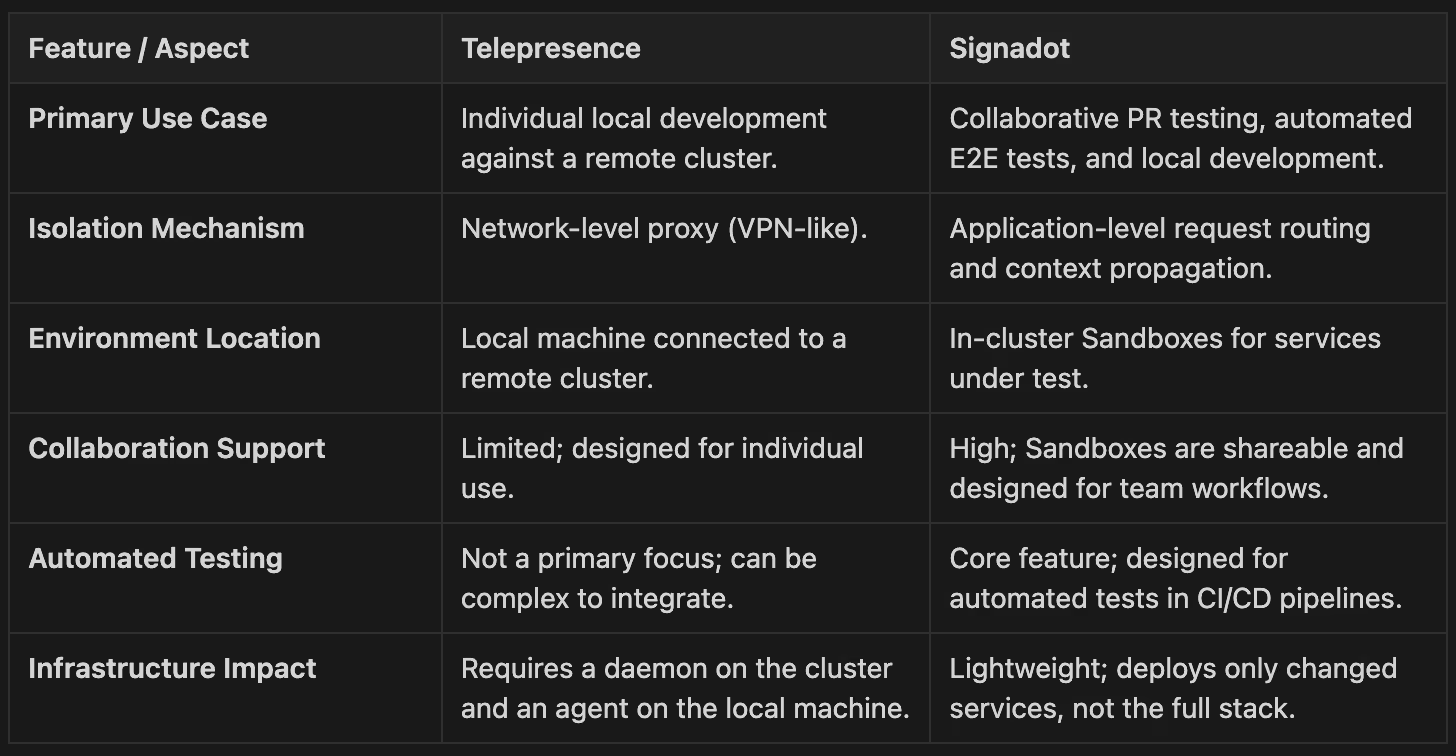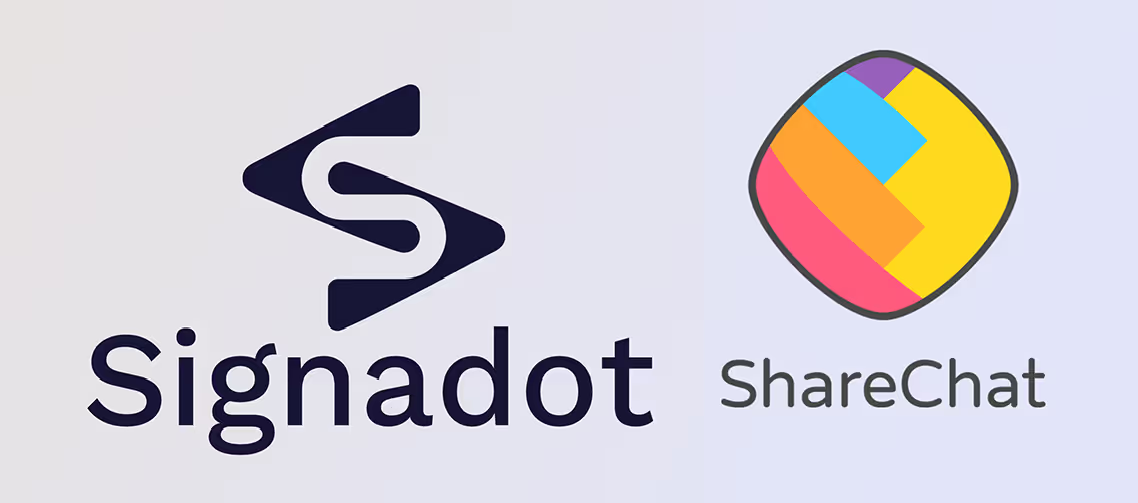Top Telepresence Alternatives in 2025

Image by Susan Q Yin from Unsplash.
The adoption of microservices architectures has introduced significant complexity into the software development lifecycle. While this architectural style offers scalability and modularity, it creates challenges for development and testing, particularly in replicating production-like environments efficiently. Tools that bridge local development with remote Kubernetes clusters have become essential for developer productivity.
Telepresence is a well-known tool in this domain, enabling developers to proxy traffic between their local machine and a remote cluster. However, the landscape of microservices development tools is evolving. This article provides a technical comparison of leading alternatives to Telepresence, examining different approaches to environment management, from direct local-to-cluster proxies to comprehensive testing platforms like Signadot.
The Core Challenge: The Microservices Feedback Loop
In monolithic applications, developers could run and test the entire system on their local machines. With microservices, this is often impossible due to the sheer number of services and their dependencies. This leads to a "feedback loop crisis" where developers must wait for long CI/CD cycles to deploy changes to a shared staging environment before they can validate them [1].
Traditional staging environments present several problems:
- Contention: Multiple developers and CI jobs competing for a single, shared environment can lead to conflicts and flaky tests.
- Cost: Replicating a full production environment for every developer or feature branch is prohibitively expensive.
- Drift: Staging environments often diverge from production, leading to tests that pass in staging but fail in production.
To address these issues, a new class of tools has emerged to create isolated, on-demand testing environments. These tools can be broadly categorized into local development proxies and ephemeral environment platforms.
Local Development Proxies: The Telepresence Model
Telepresence and its direct alternatives focus on connecting a developer's local workstation to a remote Kubernetes cluster. They work by intercepting and redirecting network traffic, allowing a single service running locally to communicate with its dependencies in the shared cluster.
Under the hood, Telepresence launches a local agent and deploys a lightweight proxy container (often called the “traffic manager”) into your Kubernetes cluster. It intercepts outbound service calls and DNS lookups, routing them over a secure network tunnel back to your local process. Responses are sent back through the tunnel, making your local code appear as if it were running directly inside the cluster.
- Local Debugging: Step through your code with IDE breakpoints while interacting with live services and databases in the cluster.
- Feature Testing: Implement changes locally and immediately validate behavior against real dependencies without a full redeploy.
- Service Simulation: Swap in a local mock or experimental version of a service to test failure scenarios or new features in isolation.
Ephemeral Environment Platforms: A Scalable Approach
While local proxies are effective for individual developer workflows, they do not fully address the challenges of collaborative testing, pull request validation, and automated end-to-end tests. Ephemeral environment platforms offer a more comprehensive solution by creating isolated testing environments within the Kubernetes cluster itself.
Signadot
Signadot provides a microservices testing platform that moves beyond local proxying to enable scalable, on-demand testing environments called Sandboxes. Instead of connecting a local machine, Signadot spins up a version of the service under test within the cluster for each pull request.
This approach is built on two core principles:
- Application-Layer Isolation: Sandboxes use smart request routing and context propagation to isolate test requests. When a request enters the system with a specific Sandbox header, it is routed to the patched versions of services within that Sandbox, while all other requests are directed to the baseline services [1].
- Resource Efficiency: Only the services being changed are deployed in a Sandbox. For all other dependencies, the Sandbox routes requests to the existing baseline services in the shared cluster, avoiding the need to duplicate the entire stack.
This model supports a broader range of use cases, including:
- Local Development: Developers can connect their local IDE to a remote Sandbox for a live debugging experience.
- Automated PR Testing: Each pull request automatically gets its own isolated Sandbox for running integration and end-to-end tests.
- AI-Powered Validation: Signadot offers SmartTests, an AI-powered capability for API contract testing, further automating the validation process.
By optimizing the development lifecycle within Kubernetes, platforms like Signadot have demonstrated significant improvements, including a reported 10x increase in developer speed and an 80% reduction in testing time for engineering teams.
Signadot's traffic routing model works natively with service meshes like Istio and Linkerd. We also offer our own sidecars based on Envoy if you don't have a mesh. This enables an extended set of use cases natively within Kubernetes and extends far beyond local development.
Other Platforms for Kubernetes Workflows
Besides Telepresence and Signadot, the following tools offer local development proxies and environment replication for Kubernetes:
- mirrord: A Telepresence alternative that injects your local code directly into a remote Kubernetes cluster, enabling live debugging and development workflows.
- vcluster: A tool for creating lightweight, virtual Kubernetes clusters inside existing clusters, providing isolated development environments that mirror production.
- Tilt: A local-first development environment that automates building, deploying, and watching of Kubernetes applications, with live updates on code changes.
- Skaffold: A command-line tool that facilitates continuous development for Kubernetes applications by automating build, push, and deploy workflows.
Feature Comparison: Telepresence vs. Signadot

Conclusion: Selecting the Appropriate Tool
Choosing the right tool depends on the specific needs and scale of the engineering organization. The landscape has evolved from tools that simply connect a local machine to a remote cluster to comprehensive platforms that manage the entire testing lifecycle within Kubernetes.
- Telepresence is an excellent choice for individual developers who need to quickly debug a single service by connecting their local environment to a shared cluster. It solves the immediate problem of local development in a microservices world.
- Signadot is designed for teams seeking a scalable and collaborative solution for microservices testing. By creating isolated, on-demand Sandboxes for every pull request, it addresses the bottlenecks of shared staging environments and enables reliable, automated integration and end-to-end testing directly within Kubernetes. This platform-level approach is better suited for organizations looking to improve overall developer velocity and testing efficiency.
Ultimately, the most effective strategy often involves a combination of these tools: a platform like Signadot to manage environments and run automated tests, integrated with API and UI testing frameworks like Postman and Cypress, all orchestrated through a robust CI/CD pipeline.
Join our 1000+ subscribers for the latest updates from Signadot







